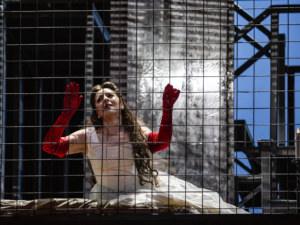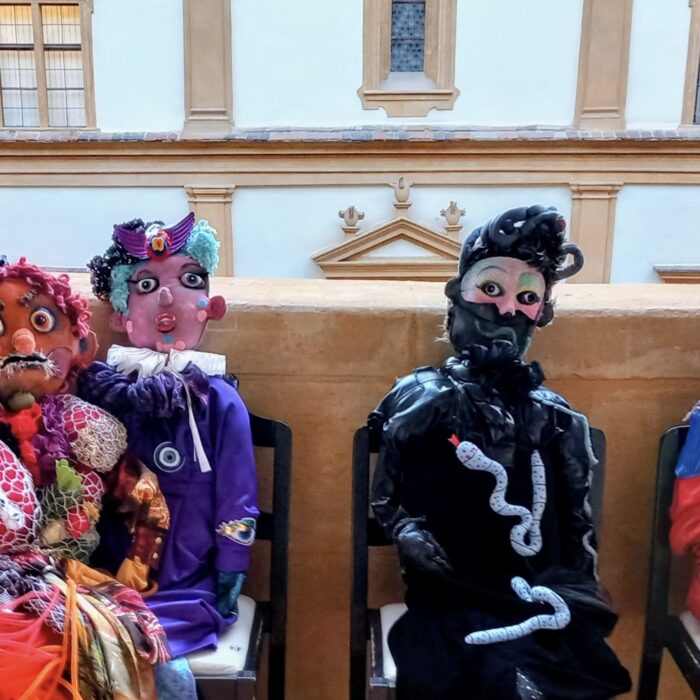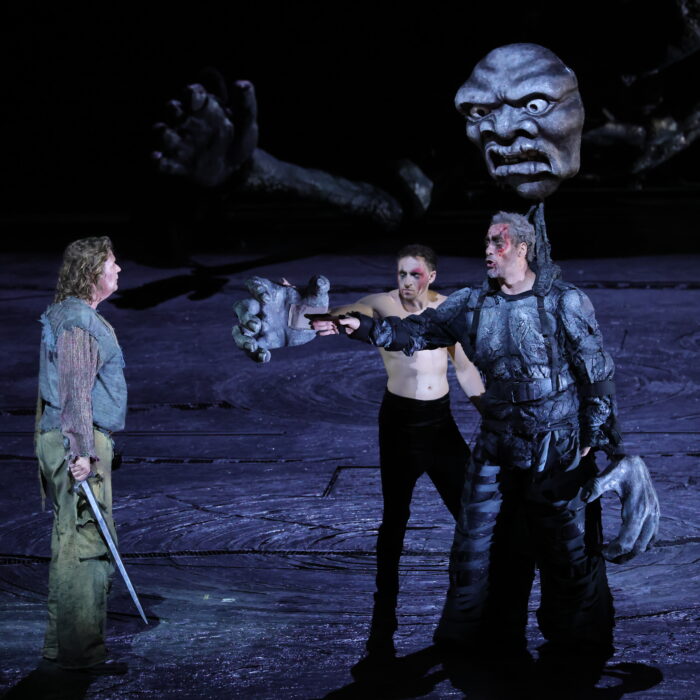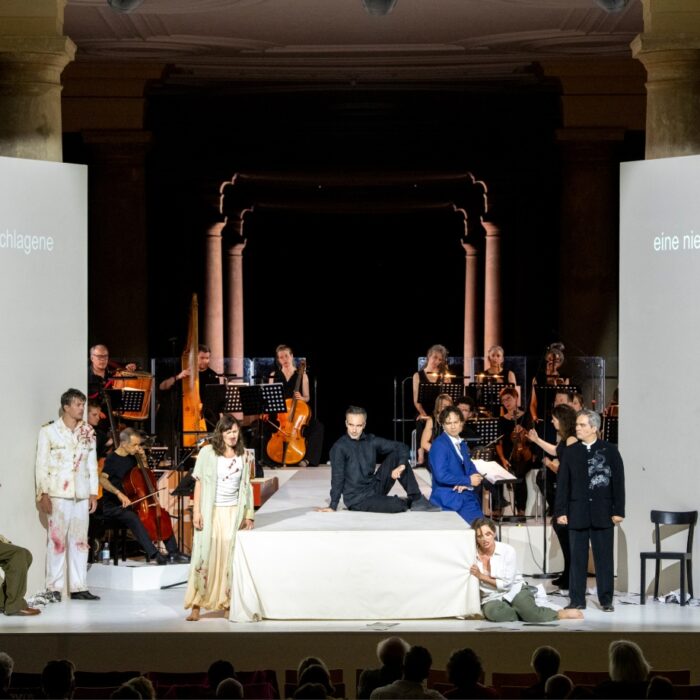
Teatro dell’Opera di Roma 2019 Review: Anna Bolena
Maria Agresta & Carmela Remigio Reign Supreme In Donizetti’s Potent Tragedy
By Alan NeilsonHalf way through the second act of Donizetti’s “Anna Bolena,” Giovanna Seymour enters the prison cell of Anna Bolena in an attempt to save her from the execution block by getting her to admit that she is guilty of adultery, precipitating a musical and dramatic confrontation between the two rivals for Enrico’s love. It is a confrontation of epic proportions, in which the two women give vent to their emotions, which shift rapidly and wildly, complicated by their own internal emotional conflicts; Giovanna torn between her love for Enrico, and her loyalty for Anna as well as her own feelings of guilt; Anna by her love and hatred for Enrico, and her jealousy, anger and pity for Giovanna.
Although a duet, it has a much freer structure than was the norm, characterized by exchanges in the form of ariosos and accompanied recitatives, with the voices only overlapping for the coda. Its focus is on dramatic immediacy, rather than form, and requires two excellent singing actresses to make the scene work.
Fortunately, for this production of “Anna Bolena” the Opera Roma had exactly that, with Maria Agresta playing the role of Anna and Carmela Remigio parted in the role of Giovanna.
Capturing the Moment
Together the two sopranos produced a thrilling scene; both singers captured the full breadth of their characters’ complex natures, inflecting their voices with a swathe of colourful emotional accents, stretched to underline the extremes of their suffering, and eventually combining in a hair-raising coda, their voices soaring strongly and clearly above the orchestra, and underpinned by intelligent use of body language to highlight their inner dignity.
The decision was taken to play the role of Giovanna as a soprano rather than a mezzo, and it proved to be an excellent one, as it produced an a greater degree of equality between the rivals, and intensified their conflict.
Gripping as it was, however, it would be wrong to conclude that the scene marked the high point of the performance, as that would be to understate the musical and dramatic impact of other scenes and the other singers.
In the final scene, set in Anna’s prison cell, Agresta changes into a white dress and bright red arm length gloves, in preparation for Anna’s execution, and in a state of delirium she imagines that it is her wedding day and sings the aria, “Piangete voi?” In a heart-rendering performance, the soprano skillfully and delicately moulded her lines, the voice gentle and graceful sailing over the the thin orchestral accompaniment, punctuated by occasional terrified outbursts when she realizes it is death for which she is preparing. Then imagining that Percy is present with her, she moved into the cabaletta “Al dolce guidami, ” in which she displayed her wonderful vocal control, spinning out long, plaintive lines, subtly embroided, with delicately crafted coloraturas and a pleasing legato, in what was a beautiful rendition.
Later in the scene, Agresta brought the opera to an end with “Coppia iniqua, l’estrema vendetta” in which she denounces the “wicked couple,” her voice now forceful, and pushed to its upper limit, and heavily accented; she moved up and down the scale in an impassioned outburst. It was an all-round potent performance from a soprano on top form.
Also Reigning Supreme
Likewise, Remigio was equally impressive in the role of Giovanna, who expertly created a complex portrait of Enrico’s lover and Anna’s friend. Her voice was strong and flexible, she sang with clarity, and was attentive to characterization.
In Act two she addresses Enrico, “Ah! pensate che revolti,” in a final attempt to convince him to show mercy to Anna. Remigio’s passionate rendition was delivered forcefully, and displayed the sparkling agility of her voice, rising vigorously and brightly above the orchestra at its climax.
Enrico was played by the bass-baritone, Alex Esposito, who gave a commanding performance in the role, strutting around the stage with the air and authority of a despot in full control. Moreover, he emphasized Enrico’s psychopathic tendencies, which gave him an extra believable dimension.
In his Act two scene, in which Giovanna pleads with him to spare Anna’s life, Enrico sings of his loathing for his wife, and wraps his hands around Giovanna’s throat. Vocally, his performance was equally forceful; his voice was authoritative, flexible with an attractive timbre, to which he added a wonderful array of colorful and dynamic inflections, delivering a subtly crafted, expressive portrait of the King.
His Act one duet with Remigio, “Ah! qual sis cercar non oso,” in which Enrico assuages Giovanna’s doubts with his ardent protestations of love, was compelling. They sang with freedom and confidence, their voices blended seamlessly and complemented each other beautifully.
Other Powerful Interpretations
René Barbera was cast as Giovanna’s forlorn suitor, Riccardo Percy, and produced an ardent, if somewhat one-paced performance. He has a strong and secure tenor, with a sweet italianate tone, with the ability to sustain long, arching phrases. His cavatina “Da quel di che, lei perduta,” in which he tells of his exile and recalls of his past love for Anna, was despatched with a confident swagger, and delighted the audience with the beauty of his delivery.
And again in his lyrical aria “Vivi tu, ben e sconiguro,” in which he refuses Enrico’s offer of clemency, Barbera was able to show off the refined qualities of his voice. However, his attention to characterization was not given sufficient attention, which he subordinated to aesthetic considerations.
Anna’s page, Smeton, was played by Martina Belli, who made an excellent contribution. Her voice has beautiful timbre, replete with an array of dark colors. The song, “Deh, non voler constringere,” sung to entertain Anna and her ladies, was delicately phrased, adorned with pleasing embellishments and small coloraturas, and splendidly captured the qualities of her voice.
Belli’s page was more aggressive than is usual, and at one point attempts to force himself upon Anna, who angrily throws him aside. Moreover, Belli made a good job of portraying a young man, helped in no more small measure by some excellent make-up.
Nicola Pamio disappointed in the role of Hervey; his voice was insecure and even on occasions sounded frail. The Ukrainian Andrii Ganchuk, from the “Young Artists Programme,” performed well in the role of Anna’s brother, Lord Rochefort. He has pleasing baritone and displayed a solid technique. His acting skills also impressed.
The Maestro del Coro, Roberto Gabbiani, had clearly rehearsed the chorus well, who gave a committed and engaging performance.
Directors Leading Queens & Kings
In the pit was the Donizetti specialist, and Musical Director of the Donizetti Festival, Riccardo Frizza, who, unsurprisingly, produced an excellent performance from the Orchestra del Teatro dell’Opera di Roma. Not only did he maintain an engaging dynamic, but successfully captured the drama’s intense ambience and inner tensions. It was a sensitive and detailed reading in which the score’s colorings were carefully drawn out from the orchestra, in what was a well-balanced performance.
Andrea De Rosa, the director, produced an engaging presentation. Focusing on the intimate emotional connections between the characters, as well as their inner turmoil and conflicts, he was particularly attentive to the development of believable, well-fleshed out personalities.
The approach proved to be very successful, especially so in the cases of Anna, Giovanna, and Enrico. Moreover, movement and gestures were well-developed, which had the effect of hardening the psychological intensity of the drama. De Rosa’s underlying idea was to present Anna, and to a lesser extent Giovanna, as prisoners of Enrico’s passions, so that from the start Anna is being encircled and imprisoned by the chorus and then by metal fencing, before being actually sent to the Tower as a prisoner.
It was also possible to see the beginnings of imprisonment taking shape in his relationship with Giovanna, his anger, and his sometimes psychotic manner, forcing her to bend to his will, which culminated in having her sit next to him to watch Anna’s execution.
Not On the Same Page
Unfortunately, the scenery and costumes, designed by Luigi Ferrigno and Ursula Tramonti respectively, were not always successful in their support of De Rosa’s vision. The set design for Act two was centred on the use of metal cages as prison cells, which were piled on top of one another, and metal fencing which was lowered from above the stage, and although the underlying idea was sound, its industrial appearance jarred against ambience of the period.
By contrast, the set for the first scene of Act one, although simple in design, was more aesthetically pleasing, consisting of a dark raised platform with dark walls, with a blood red backdrop, which surrounded a central performance space, and which, along with the dark colored costumes of the chorus and the candles which dimly lit the stage, created a suitably claustrophobic atmosphere suggestive of Anna’s creeping imprisonment. Props were always kept to the minimum, which worked to good effect, but why was an inappropriate 19th century hunting rifle introduced into the hunting scene?
More irritating than damaging were Tramonti’s costume designs. Clearly, they were aimed at creating a Tudoresque feel, and they were certainly pleasing on the eye, but they were unnecessarily historically inaccurate; Smeton’s red and black, long jacket was more appropriate to the mid 18th century than Tudor England, the male chorus and principal singers wore trousers, rather than traditional hose, and so on.
Given that the characters are so embedded in the period, and in which an attempt was clearly made to create the ambience of the Tudor court, why did Tramonti not stick to accurate costumes? Nothing was gained by her decision to choose such an eclectic mix of clothing from different eras.
Enrico Bagnoli’s lighting was similarly hit and miss. He made use of stark contrasts to successfully differentiate scenes, and his use of dark lighting really added to oppressive nature of the court. His final use of a large bank of spot lights, lowered from above, to overwhelm the execution scene, may have been a good idea, but it did not really work, and was another example of an aspect of the production which just did not quite fit.
Overall, Opera Roma’s production was music making of the highest standards, with tremendous performances from Agresta, Remigio and Esposito, in particular. Moreover, it was supported by De Rosa’s excellent direction which brought depth to the characters, and captured the oppressive regime and atmosphere that dominated Enrico’s court, and Anna Bolena’s imprisonment, although the scenery and lighting were of a more inconsistent standard, and the costumes did not always convince.


